Is Carpet in Kitchen Areas Always a Bad Idea?
Author: Rick Worst | Editor: Omar Alonso
Review & Research: Jen Worst & Chris Miller
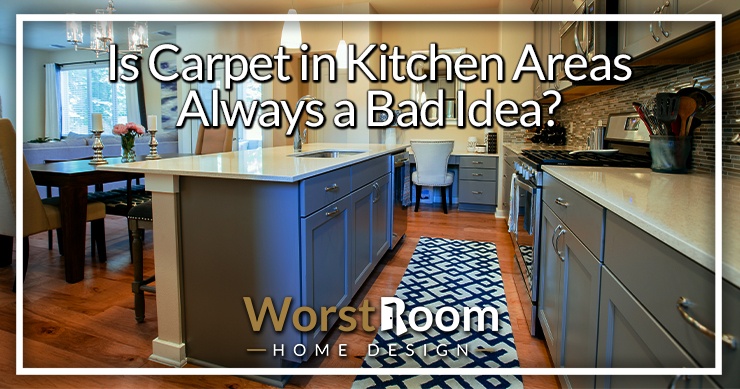
How much time do you spend in the kitchen? How do your floors look? If you have tile, laminate, or vinyl floors, how’s that working out for you? While some homeowners might think this suggestion is crazy, have you ever considered adding carpet in kitchen areas?
We’re not suggesting you do wall-to-wall carpeting, but a few strategically placed rugs might turn your sterile-looking kitchen into a more comfy and welcoming space, wouldn’t you agree?
Whether you wince at the idea of kitchen with carpet or think it’s worth a try, it’s definitely worth investigating. This post unpacks the case for both arguments. Let’s look at the pros and cons and make a verdict.
Why Bother Installing a Carpet in the Kitchen?
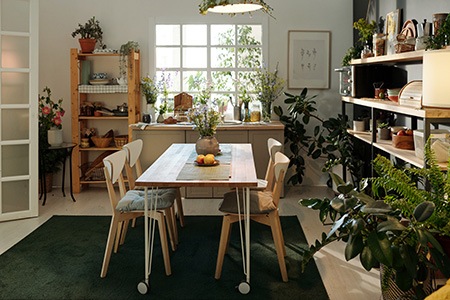
Adding a carpet to the kitchen might not be the horror show you expect. Most homeowners can’t imagine doing it, but with a few careful placements, you might be surprised how it turns the room around.
A carpet or rug brings together the decor in the room, typing together the design elements in the floors, walls, and furniture for a more harmonious look. A carpet brings more color and texture to an otherwise neutral room, giving it more life.
Carpets or various types of rugs in the kitchen can serve many purposes, like absorbing water and spills. However, that functionality might be a double-edged sword. While it means less mopping, it could also turn the carpet into a sodden, smelly mess.
Regardless of what you think about adding a carpet or rug to the kitchen, we think it’s worth investigating the issue. Let’s dive into the pros and cons of the subject.
What are the Pros of Kitchen Carpeting?
A kitchen with carpet can carry a few benefits you may not have considered. It sounds strange because it’s something you’ve likely never seen. But between rugs or even wall-to-wall kitchen carpet, there can be more than several reasons to consider doing it.
Traps Dirt From Entering Other Rooms
How many times have you walked out of the kitchen into another room, only to find you’re dragging in messy kitchen waste under your feet? Happens all the time, right? Seeing the debris work its way into your Persian rug in the lounge is a heartbreaking experience, and you can imagine the cleaning effort required to remove it.
A rug or carpet in kitchen areas stops this from happening. Strategically placing a rug near the entrance traps all the dirt and debris you might drag into the other rooms, saving your other carpets and rugs. We’re not suggesting you need to go large and frame up an expensive rug in the kitchen, but adding a stylish and affordable piece to the floors might not seem like such a bad idea.
Stop Slips & Falls
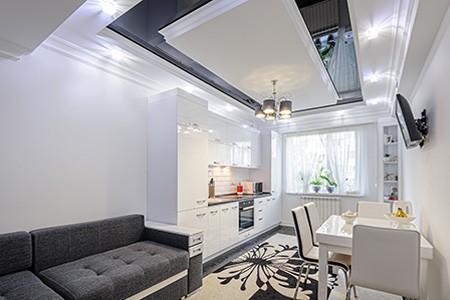
Laminate and kitchen floors tend to get pretty slippery from time to time when you spill some water or liquid. Most of the time, we’re in such a tizzy prepping meals and cooking that we think we’ll take care of it later.
A few seconds pass, and you forget the wet spot is there, and your feet slip out from you, landing you on the floor, wondering why you didn’t bother to mop it up while you were waiting for the pasta to finish. Adding a carpet or rug to the floor stops this problem. You get more traction around the area, and there’s no chance of slipping.
Materials like polyester, nylon and blended fabrics offer you a slip-resistant, absorbent surface that’s fairly easy to clean. Even if you slip, which is unlikely, landing on the carpet softens the impact, compared to landing on a hard tiled surface.
Protect Your Floors
Laying a carpet or rug in the kitchen provides protection for sensitive flooring materials. If you have a hardwood kitchen floor, laying a rug stops you from damaging the wood when dropping pots and pans or spilling something. You don’t have to worry about that spilled pasta water getting between the floorboards, causing them to lift and warp.
Quiet the Noise
Tiled and laminate kitchen floors create an eerie acoustic environment. They seem hollow, and you can swear you hear an echo sometimes if the room is big enough. This audio effect makes the kitchen a noisy place.
It’s easy to make a racket in the kitchen, banging pots and pans, cutlery, and crockery. Don’t get us started on the noise of cooking with the wok and a steel ladle. It’s almost enough to make you want to wear earmuffs while cooking.
A carpet or rug absorbs some of this noise and stops it from bouncing around the room, dampening the sharp sounds in the kitchen. There’s less fear of rousing the household with your footsteps and opening and closing the fridge door when you venture into the kitchen for that midnight snack.
Soft on the Feet
Tiled and laminate kitchen floors can get cold in the winter, especially if you live along the eastern seaboard. Sometimes, the cold from the floor seems like it pierces through your footwear, making your feet icy. Instead of splashing out cash on underfloor heating, go with a carpet in kitchen areas instead.
Attractive Design Aesthetic
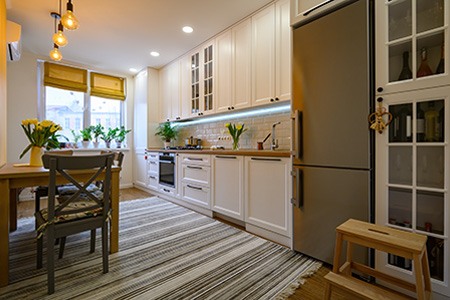
While some tiling and laminate flooring options have attractive designs, nothing adds to a design aesthetic more than an attractive rug in the room. Bring one into the kitchen and turn it from a cold and sterile room for a cozy look that spruces up the design. One might even opt for wall-to-wall kitchen carpet.
What are the Cons of Carpet for Kitchen Floors?
I’m sure the first thing you think of when considering carpet in the kitchen is “what about all the food, crumbs, oil, and grease popping everywhere?” because that’s what I thought too. Knowing how to get grease out of carpet is one thing, and doing it successfully is another.
And you’d be right, it's tough, which is why washable mats may be best near the sink and stove. What are some other negatives of a kitchen with carpet?
Challenging to Clean Dropped Food
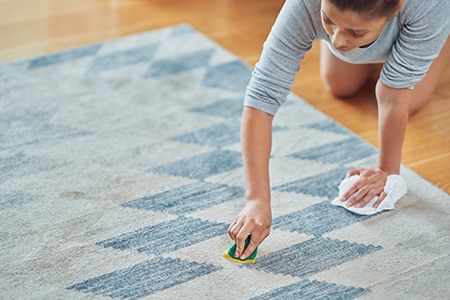
The problem with fitting a carpet in the kitchen is the mess. We’re always spilling and dropping liquids and food on the floor. A carpet absorbs these spills and drops, staining the material. Sure, you could go with a darker rug, but spilling something oily on it looks gross and feels terrible underfoot, especially if you’re barefoot in the kitchen. Cleaning a dirty carpet isn’t easy, especially when it’s got kitchen waste on it.
Potential for Allergy Flares
A sodden carpet is an attractive breeding ground for mold and bacteria. If you have allergies or asthma, you might end up experiencing flares in these health issues, especially if mold starts releasing spores into the air. Check out what the National Center for Healthy Housing (NCHH) has to say in their carpeting fact sheet found here if this is an issue for you.
The Carpet Might Smell
By far, the worse issue involved with bringing a carpet kitchen areas is the potential for smells and unpleasant odors. Dropping food waste or cooking water and oils onto the carpet might not seem like a big deal at the time, but give it a few days. Your carpet will stink like feet and nasty food and oils very quickly.
As the waste turns rancid and begins to rot, all those lovely odors will puff up into the air in the kitchen, leaving it smelling like a trash can on collection day. Can you imagine the horror of a guest coming over and turning up their nose as they enter the kitchen? Or having ants in the carpet crawling up their leg?
Does a Rug Look Good in the Kitchen?
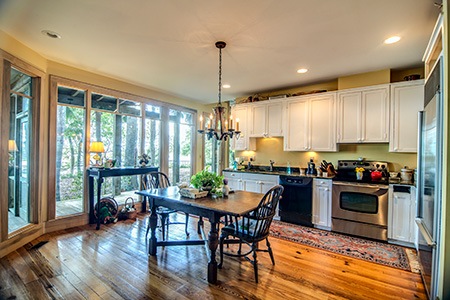
Sure, what room doesn’t benefit from the design aesthetic of an attractive rug? It adds more variability to the room and ties everything together nicely. Rugs and carpets are fashionable design elements, and they definitely add some flavor to the overall look of the kitchen.
If you have a chipped tile in the kitchen, covering it with a rug means you don’t have to go through the hassle of digging out and replacing the broken tile. Or if you move into a home with a ghastly-looking laminate kitchen floor, adding a rug to the space spruces it up, detracting from the poor design decision made by the previous owner.
Carpets and rugs come in many different designs and colors, allowing you to choose one that offsets or complements the kitchen floors and walls. Overall, it doesn’t seem like a bad idea to improve the decor in the space with a pretty, affordable rug. This is the same kind of conversation about installing a ceiling fan in the kitchen. It can look fine, but is it a smart idea?
What Carpets are Most Appropriate for the Kitchen?
If you’re going to add a rug or carpet to the kitchen, go with something made from durable, easy-to-clean fibers. If the rug can’t stand up to harsh conditions in the kitchen, then it has no place in the room.
So, what materials should you look for in a good kitchen rug or carpet? We recommend going with synthetic blended materials. These options have great durability; they’re the easiest to remove stains from and clean.
Many of these options come in attractive designs and hundreds of colors to complement your kitchen aesthetic. Look for materials offering water and stain resistance. These fabrics make it easy to do daily or weekly maintenance on the rug, preventing it from absorbing waste that stinks out of the room.
Some synthetic materials are more expensive than others, but it’s worth paying a little extra for something that’s functional and long-lasting.
Carpet in Kitchen Areas? You Should Probably Avoid It
Overall, we have to say that a carpet or rug doesn’t belong in the kitchen, especially around areas where you prep food. The smell and cleaning just put us off, and we can’t recommend you do so. However, there is some merit to using a rug on the entrance, or to cover up damage or improve the design of a poorly laid out tile or laminate floor.
It all comes down to what you think would be the better option and what you’re prepared to live with every day in the kitchen. So, which is the better choice for you? Just remember, carpet in kitchen areas come with a lot of challenges.



